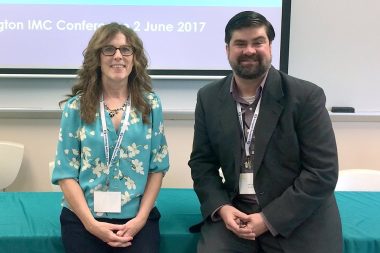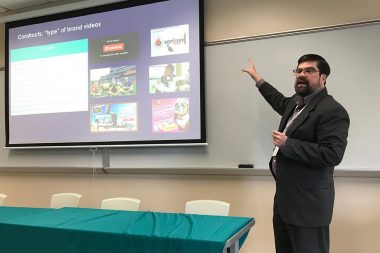Lee Bush and Hal Vincent from the School of Communications attended the Integrated Marketing Communications Conference in Wilmington, N.C., and shared their insights on user-generated selfies and live video, and the implications of this social content in both developing and teaching communications strategies.
Associate Professor Lee Bush and Lecturer Hal Vincent recently presented research at the fourth biennial Integrated Marketing Communications Conference, discussing the rise of selfie culture and its implications for teachers and professionals in strategic communications. The conference, hosted by the University of North Carolina at Wilmington from June 1-3, drew integrated marketing communications (IMC) researchers from as far away as Alaska and Germany.

In her presentation, titled “Student use of ‘selfie culture’ as brand engagement in the Strategic Communications Campaigns course,” Bush explored the use of selfies as a new form of visual dialogue, and how consumer creation of “branded selfies” can extend brand experiences and co-create brand meaning. She also discussed how student participation in selfie culture can help students better understand the concept of brand engagement and showed several examples from student campaigns for Biscuitville and Food Lion. Bush ended her presentation with a teaching module that uses selfie culture to teach campaign strategy in Elon’s “Strategic Campaigns” course.
During Vincent’s presentation, “Who is the star of live-video? Streaming video in the media mix of clients in a student-run communications agency,” the lecturer shared a content analysis of branding tactics as it pertains to created content and live video conducted and applied by students of Live Oak Communications, Elon’s student-run advertising and public relations agency, in the spring 2017 semester. The presentation included a framing analysis of the literal and figurative “star” of brand videos, displayed student work of several constructs identified in brand video, and addressed considerations and implications of live video in academic and professional settings.
 Bush and Vincent both said they were inspired by the opportunity to share with and learn from such a diverse audience of communications and business scholars about popular culture and its profound redefining of marketing communications in light of rapid technological advancements.
Bush and Vincent both said they were inspired by the opportunity to share with and learn from such a diverse audience of communications and business scholars about popular culture and its profound redefining of marketing communications in light of rapid technological advancements.
“We have moved beyond simply acknowledging digital media as a platform, to studying the different forms and symbolic meanings of communication used within digital media and the implications of those for strategic communications strategy,” said Bush.
Vincent added, “as communications platforms change, audiences wants and demands from brands change, and how we create and process messages change, so too does our teaching and execution of IMC in student experiential learning environments if we want to ensure they are prepared for future success.”
About Live Oak Communications
Live Oak Communications is Elon University’s student-run strategic communications agency, providing students unique experiences partnering with numerous businesses, nonprofits and organizations to achieve their business goals through targeted, multiplatform strategies and tactics. Live Oak Communication’s capabilities include public relations, advertising, video, web design, social media solutions, graphic design, corporate identity and more.


